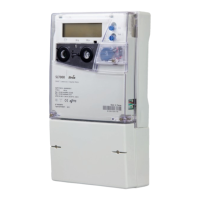EOB summary registers
These historical buffer registers record a specific set of values associated with end of billing (EOB) events, as
follows:
• number of EOB actions (cumulative)
• EOB date and time
• EOB source trigger:
• communication
• control input
• front-panel pushbutton
• programmed calendar dates and times
• since the last EOB event, the:
• number of days
• average power factor
• minimum power factor
• min/max distribution-network frequency
6.10. Network quality monitoring
As a manufacturing option, 4 wire system meters can be configured to monitor various distribution-network
voltage quality parameters. However, this facility is only available if specifically requested at the time of
manufacture and it is not available on 3 wire system meters.
The meter detects voltage-quality defect events by continually sampling and analysing the per phase RMS
voltages (Urms) and comparing these voltages against a series of pre-defined values.
These values are thresholds which the sampled phase voltage must either fall below, or rise above, depending
on the defect type being recorded. Typically, for each defect event there is a high and a low threshold value,
crossing one threshold starts the event, crossing the other finishes it.
Threshold values are independently programmed using the meter support tool and can be either fully user-
defined or set to defaults calculated as a percentage of the nominal input voltage (Unom).
The meter calculates the magnitude of the defect as an average value over the duration of the event.
For all defect magnitude calculations, the first and the last 40 ms period of the defect is not taken into account. If
the defect does not last at least 120 ms, the defect magnitude is set to zero, whatever defect type.
For each voltage-quality defect event, the meter records the:
• phase involved
• start and end times (with a one second resolution)
• duration in tens of milliseconds (with a fixed accuracy of +/- 80ms)
• average level (with a 0.5% accuracy in 1/100 Volt limited to the first 2 hours)
Certain parameters of each defect type are recorded as historical meter data for subsequent analysis, such as:
• number of defects per phase (incremental)
• cumulated duration of defects per phase
• duration of the longest and the shortest defects per phase (with time stamp)
• 10 last defects (with time stamp, duration, magnitude, phase)

